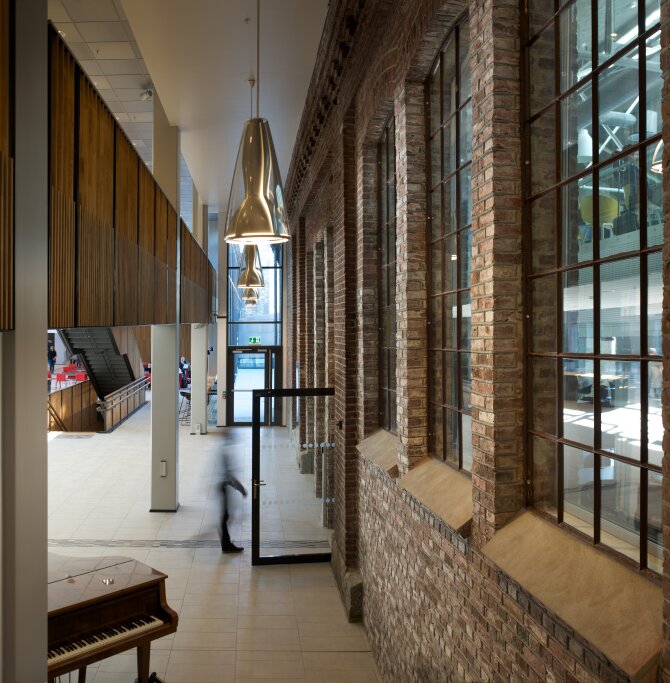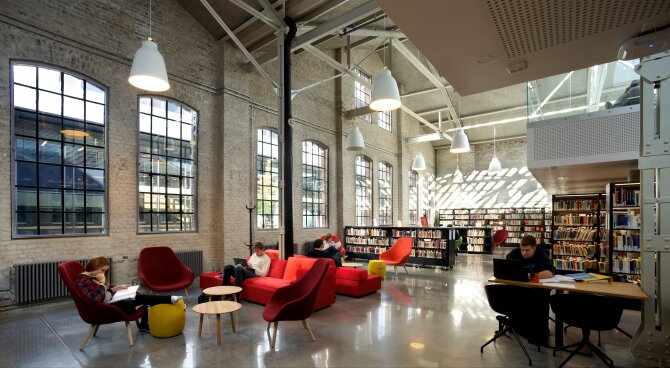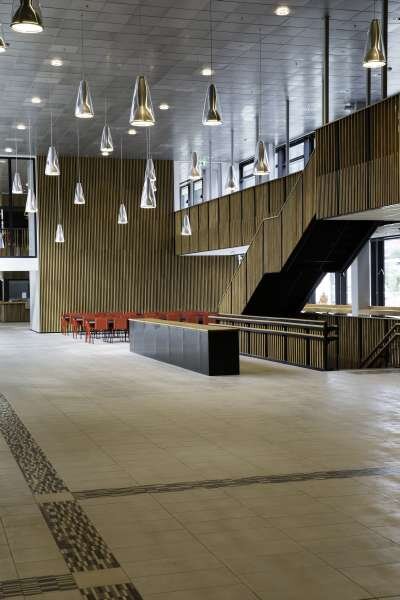Bergen University College
Bergen University College - Kronstad (now part of Western Norway University of Applied Sciences HVL) is a pioneer in acknowledging the need for inclusive design and has become a popular place that inspires learning for everyone, both during and after school hours.
Client: Statsbygg
Architecture & interior architects: HLM Arkitektur AS, Metropolis Arkitektur & Design AS, Cubo Arkitekter
Background: The development of the new university college campus at Kronstad in Bergen began in 2002 and it was established early on that universal design was going to be part of the main solution. Winner of the Innovation Award for Universal Design 2014 in the category of Furniture and interior by Design and Architecture Norway and The Norwegian Ministry of Children, Equality and Social Inclusion
Lead users:
Students, teachers
Methods:
A strategic document ensouring inclusive design principles
Awards:
Category winner Furniture and Interior Design, Innovation Award for Universal Design 2014 by Design and Architecture Norway and The Norwegian Ministry of Children, Equality and Social Inclusion. Grand Award 2022, IAUD International Inclusive Design Award.
51.000 m2
of Inclusive urban space
It’s essential to include expertise in universal design as early as the project planning phase, before delivery. Universal design must be part of the main solution.
CHALLENGE
The university college campus at Kronstad in Bergen is a long-term project that started in 2002, long before universal design was articulated as a formal requirement. Even so, Statsbygg was a pioneer in acknowledging the need for such design, and in seeing possibilities rather than barriers. The premises with the old workshops of NSB’s large buildings covering 52,000 m² railway tracks and old gates, constituted a district in itself. How could the buildings be preserved and connect three different institutions in a coherent way, and how can universal design result in an inclusive environment which invites to learning in a social place for everyone?

APPROACH
This project at the new university college campus at Kronstad consists of new construction, transformation of older buildings, looking after sites of special interest, and the creation of large outdoor areas. Universal design was integrated into high-quality interior designs, ensuring that the campus better support both employees, students and visitors.
When Statsbygg announced the competition for the construction of the new university college campus, there was no requirements for universal design, but they knew that they would come, sooner or later. The goal was therefore to satisfy these requirements from the start, without extensive and expensive changes later on. For this reason, a strategic working document was drawn up with specifications and requirements, and details of the issues to solve during the various phases. As a result, the university college was, among other achievements, one of the first in Norway that had ramps integrated into the first floor plan.
We have had many meetings with users, and we were also able to draw on our long experience. All the time, we have intended that the college could be seen as a small village. Universal design should be implemented in a very inclusive way since we wanted the university college to be open for everyone, including people who lived in the neighbourhood.
The keyword for the project was ‘connect’: Connection between old and new, the past and the future, small and large, and three institutions in one location. However, it was also necessary to look at the construction and its relationship with the surroundings, the city and the neighbourhood. In order to understand the interior of a building it is important to understand the building in its entirety.
The architects wanted as much light as possible with as low energy consumption as possible and created atria between each of the seven departments. The atria fill the university college with natural light and enable users to orient themselves relative to existing buildings or landmarks in the city.
In order to reduce the need for focused light, contrasting elements were used where possible, such as doors in contrast with walls, flooring beads, etc.
The principle circulation around the university college both between and within the buildings is simple to understand due to step-free, easily understood patterns of movement. The transitions between indoors and outdoors are open, making it easy to find and use informal zones. The furniture invites visitors to spend time at the university in several different ways, taking different disabilities and preferences into account. This means that the architecture and furnishing invite everyone to use the college actively, not just during normal school hours.

RESULT
Bergen University College at Kronstad enriches the city. The complete district has benefited from gaining an urban space that is available to everyone. Modern architecture and design are delightfully connected with the history and culture of the site through rehabilitation of the old workshop halls and their current and continued use.
One of the most important aspects is the way in which universal design at the university college acknowledges and takes seriously the idea that everyone has the right to participate in higher education and in social forums. Not least have the attractive educational facilities at the college led to competition among applicants.
The university college has become a popular place to be, whether the user wants the seclusion to study or to indulge in social activities.


